Question
Function
Evaluate the derivative
Find the domain
Find the x-intercept/zero
Load more

y′=3x2−14x
Evaluate
y=x3−x2−6x2
Simplify
More Steps


Evaluate
x3−x2−6x2
Subtract the terms
More Steps


Evaluate
−x2−6x2
Collect like terms by calculating the sum or difference of their coefficients
(−1−6)x2
Subtract the numbers
−7x2
x3−7x2
y=x3−7x2
Take the derivative of both sides
y′=dxd(x3−7x2)
Use differentiation rule dxd(f(x)±g(x))=dxd(f(x))±dxd(g(x))
y′=dxd(x3)−dxd(7x2)
Use dxdxn=nxn−1 to find derivative
y′=3x2−dxd(7x2)
Solution
More Steps


Calculate
dxd(7x2)
Use differentiation rule dxd(cf(x))=c×dxd(f(x))
7×dxd(x2)
Use dxdxn=nxn−1 to find derivative
7×2x
Multiply the terms
14x
y′=3x2−14x
Show Solution

Testing for symmetry
Testing for symmetry about the origin
Testing for symmetry about the x-axis
Testing for symmetry about the y-axis
Not symmetry with respect to the origin
Evaluate
y=x3−x2−6x2
Simplify the expression
y=x3−7x2
To test if the graph of y=x3−7x2 is symmetry with respect to the origin,substitute -x for x and -y for y
−y=(−x)3−7(−x)2
Simplify
More Steps


Evaluate
(−x)3−7(−x)2
Multiply the terms
(−x)3−7x2
Rewrite the expression
−x3−7x2
−y=−x3−7x2
Change the signs both sides
y=x3+7x2
Solution
Not symmetry with respect to the origin
Show Solution

Solve the equation
y=x3−7x2
Evaluate
y=x3−x2−6x2
Solution
More Steps


Evaluate
x3−x2−6x2
Subtract the terms
More Steps


Evaluate
−x2−6x2
Collect like terms by calculating the sum or difference of their coefficients
(−1−6)x2
Subtract the numbers
−7x2
x3−7x2
y=x3−7x2
Show Solution

Rewrite the equation
r=0r=2cos3(θ)7cos2(θ)−cos(θ)(49cos(θ)+4sin(θ))×∣cos(θ)∣r=2cos3(θ)7cos2(θ)+cos(θ)(49cos(θ)+4sin(θ))×∣cos(θ)∣
Evaluate
y=x3−x2−6x2
Simplify
More Steps


Evaluate
x3−x2−6x2
Subtract the terms
More Steps


Evaluate
−x2−6x2
Collect like terms by calculating the sum or difference of their coefficients
(−1−6)x2
Subtract the numbers
−7x2
x3−7x2
y=x3−7x2
Move the expression to the left side
y−x3+7x2=0
To convert the equation to polar coordinates,substitute x for rcos(θ) and y for rsin(θ)
sin(θ)×r−(cos(θ)×r)3+7(cos(θ)×r)2=0
Factor the expression
−cos3(θ)×r3+7cos2(θ)×r2+sin(θ)×r=0
Factor the expression
r(−cos3(θ)×r2+7cos2(θ)×r+sin(θ))=0
When the product of factors equals 0,at least one factor is 0
r=0−cos3(θ)×r2+7cos2(θ)×r+sin(θ)=0
Solution
More Steps


Factor the expression
−cos3(θ)×r2+7cos2(θ)×r+sin(θ)=0
Solve using the quadratic formula
r=−2cos3(θ)−7cos2(θ)±(7cos2(θ))2−4(−cos3(θ))sin(θ)
Simplify
r=−2cos3(θ)−7cos2(θ)±49cos4(θ)+4sin(θ)cos3(θ)
Separate the equation into 2 possible cases
r=−2cos3(θ)−7cos2(θ)+49cos4(θ)+4sin(θ)cos3(θ)r=−2cos3(θ)−7cos2(θ)−49cos4(θ)+4sin(θ)cos3(θ)
Evaluate
More Steps


Evaluate
−2cos3(θ)−7cos2(θ)+49cos4(θ)+4sin(θ)cos3(θ)
Simplify the root
−2cos3(θ)−7cos2(θ)+cos(θ)(49cos(θ)+4sin(θ))×∣cos(θ)∣
Use b−a=−ba=−ba to rewrite the fraction
2cos3(θ)7cos2(θ)−cos(θ)(49cos(θ)+4sin(θ))×∣cos(θ)∣
r=2cos3(θ)7cos2(θ)−cos(θ)(49cos(θ)+4sin(θ))×∣cos(θ)∣r=−2cos3(θ)−7cos2(θ)−49cos4(θ)+4sin(θ)cos3(θ)
Evaluate
More Steps


Evaluate
−2cos3(θ)−7cos2(θ)−49cos4(θ)+4sin(θ)cos3(θ)
Simplify the root
−2cos3(θ)−7cos2(θ)−cos(θ)(49cos(θ)+4sin(θ))×∣cos(θ)∣
Use b−a=−ba=−ba to rewrite the fraction
2cos3(θ)7cos2(θ)+cos(θ)(49cos(θ)+4sin(θ))×∣cos(θ)∣
r=2cos3(θ)7cos2(θ)−cos(θ)(49cos(θ)+4sin(θ))×∣cos(θ)∣r=2cos3(θ)7cos2(θ)+cos(θ)(49cos(θ)+4sin(θ))×∣cos(θ)∣
r=0r=2cos3(θ)7cos2(θ)−cos(θ)(49cos(θ)+4sin(θ))×∣cos(θ)∣r=2cos3(θ)7cos2(θ)+cos(θ)(49cos(θ)+4sin(θ))×∣cos(θ)∣
Show Solution

Graph
